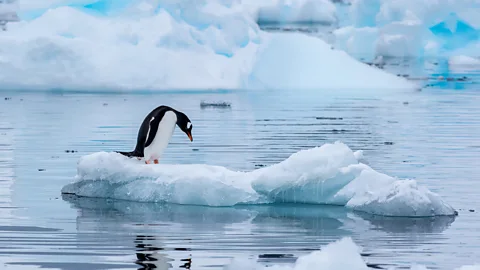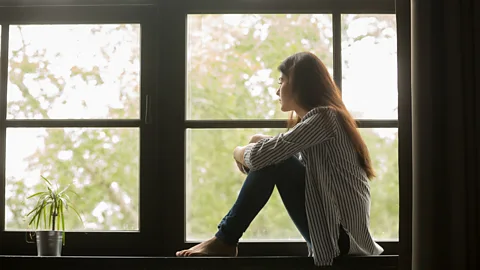Pico Iyer on the secret of immersive travel
 mantaphoto/Getty Images
mantaphoto/Getty ImagesThe celebrated writer reflects on how this once-in-a-lifetime experiment of global stillness can teach us to see the world with new eyes.
I walked off a cruise ship this January, having sailed for 10 days around the Antarctic Peninsula, in a rare state of exaltation. I’d wandered among a huge colony of penguins before, in Patagonia, but nothing had prepared me for standing, day after day, surrounded by the irresistible birds as they waddled past, threw back their heads to squawk, or glided, with surpassing grace, through the icy water.
I’d seen calving glaciers in Alaska, but that somehow paled next to the sensation of drifting in a 10-person Zodiac for one midsummer morning across a sea of turquoise and aqua and silver icebergs. Even the time I’d watched my mother swim with dolphins in Tahiti, 20 years ago, was nothing next to the sight of 50 orcas porpoising beside our ship in bright light, long after dinnertime.
 Ray Hems/Getty Images
Ray Hems/Getty ImagesWhat was it that had transported me so profoundly, I wondered? Of course, there’s a special clarity in sailing through a noiseless world where there’s often no sign of human habitation. And nearly all my fellow passengers seemed as liberated as I by the fact that phone calls were almost impossible on the ship and the internet punitively slow. Every morning, a four-page digest of news told us of a virus in faraway Wuhan, but that barely translated to this unpeopled landscape with its 360-degree horizons. Yet the deepest reason why I was moved, I came to realise, was that I spent so much of each day sitting still.
It’s a relationship that has come to haunt me more and more over 46 years of travel: my capacity to be stirred is in direct proportion to my ability to be quiet. That’s one reason why, whenever I visit Midtown Manhattan, I reflexively seek out St Patrick’s Cathedral to inhale, in silence, everything I’ve just experienced and to prepare myself for the honking horns and noisy meetings to come. It’s also the reason so many of us try to sit on a rock in Petra before the tour buses arrive, or walk along the treeless emptiness of Iceland at 02:00 in mid-June when the sun is just beginning to sit on top of the sea.
We’re most transported when we’re least distracted. And we’re most at peace – ready to be transformed, in fact – when most deeply absorbed. I’d much rather converse with one sight for 60 minutes than 60 places for one minute each. When I travel with the Dalai Lama – as I’ve done for 10 recent Novembers across Japan – I’m convinced that the wide-awake responsiveness he brings to every last convenience store and passing toddler is partly the result of the three hours he spends at the beginning of every day in meditation. Destinations can only be as rich as what we bring to them.
 mantaphoto/Getty Images
mantaphoto/Getty ImagesDuring this new season of the virus, I’ve been spending many happy hours on the tiny sunlit terrace outside my apartment in Nara, Japan, with the poet laureate of lockdowns, Marcel Proust. I think of him also as the patron saint of travellers, precisely because he was confined by severe asthma to spending three years alone in his cork-lined bedroom. What allowed him to read with such acuity the small print of every crowded soiree? To recall with such fresh immediacy a long-ago gaggle of young beauties on a beach? To record with wakeful precision the sight of a loved one asleep? That time in solitary, I suspect. It was Proust, I never forget, who reminded us that the point of every trip is not new sights but new eyes. Once we have those, even the old sights are reborn.
I think, too, of the preternatural vividness of Emily Dickinson. Not leaving her house for 26 years brought her to such a high pitch of attention that she could see South Pole and North – and wild nights and heaven and carriage-rides with death – just by standing at her window. It was through going nowhere that she made everywhere seem wondrous.
You may also be interested in:
I got my own first taste of the richness and stimulation of sitting still on one of my greatest adventures, 29 years ago, when I drove to a Catholic hermitage three and a half hours from my parents’ home in California. I stepped, on arrival, into a room consisting of a single bed, a long desk, a chest of drawers and windows looking out on a private walled garden and the still, blue plate of the Pacific Ocean, extending in every direction, 1200ft below. In the absence of disturbances – no television, no telephone reception, no internet connection – every tolling bell seemed momentous. I noticed every Steller’s jay as I never did when they alighted outside my room in my family home. Nothing I’d seen in Bhutan or Ushuaia had carried me so far or deep. I’m not a Christian but I realised that silence is non-denominational.
 fizkes/Getty Images
fizkes/Getty ImagesThree days later, of course, I was back in my all-over-the-place, multitasking, split-screen life. But those three days in silence opened a door to possibility, to the point where, by now, I’ve returned to stay in that hermitage more than 90 times, on occasion for as long as three weeks.
More than that, it’s thrown a fresh light on all my other travels. Returning to Myanmar four years ago, I simply took myself every morning, before breakfast, to the Shwedagon Pagoda: there was no need to go anywhere else, since young lovers, schoolkids, nuns, family historians – the entire city – seemed to be walking past me. Every time I visit San Francisco now, even on business, I try to take a long walk soon after I wake up, and not to go online for as long as possible. I’d rather see the world around me than be back amidst presidential tweets or messages from my bosses.
I think back to the teenager who bumped by bus from San Diego to Bolivia in 1975. At that time, I was so excited by new stamps in my passport and the prospect of telling my friends I’d crossed a pass at 15,000ft and stayed (inadvertently) for three nights in a house of ill repute that I measured my days by the quantity of experiences they threw up. It took years of travel to appreciate how a single morning in Kyoto, wide-awake in a quiet garden, could transform me more than any packed three-week itinerary across Asia.
 manjik/Getty Images
manjik/Getty ImagesMany of us now are waiting to emerge from long weeks of enforced stillness and to think about what travel can be in the future. In my case, discouraged from taking buses or trains, my wife and I enjoy walks every day around our neighbourhood and have discovered a bamboo forest, lined with flowering cherry trees, only five minutes from the apartment where we’ve been living for 27 years. Staying inside has helped me notice the light, the song of nightingales, even an occasionally passing motorbike as never before.
I’ve also got to hear from my too-seldom encountered best friend, reporting that he’s on his way to Antarctica next February. How should he prepare, he asked? I told him to read Admiral Byrd’s book, Alone, about all that the famous explorer discovered while trapped inside a tiny space near the South Pole, alone, for five months. I also told him to make the most of his stillness in advance. No-one has yet mastered the art of seeing the world deeply while running around.
Pico Iyer is the author of 15 books, translated into 23 languages, including The Art of Stillness and, most recently, Autumn Light and A Beginner’s Guide to Japan.
If you liked this story, sign up for the weekly bbc.com features newsletter called "The Essential List". A handpicked selection of stories from BBC Future, Culture, Worklife and Travel, delivered to your inbox every Friday.
{"image":{"pid":""}}
